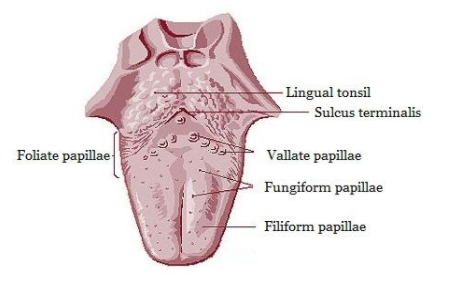
Which of the following papillae do not contain taste buds?
A. Filiform
B. Fungiform
C. Circumvallate
D. None of the above
Answer
497.7k+ views
1 likes
Hint: Papillae are humps present or rest on the surface of the tongue and these papillae give the tongue a rough touch. Taste buds which are a sensory organ sit on these papillae which comprise four basic tastes, i.e., sour, sweet, salt and bitter.
Complete answer:
Based on the types of Papillae tongue have four kinds of papillae i.e. filiform, fungiform, foliate, circumvallate. As shown in the figure:

A. Filiform papillae are the most common type of papillae having a wired shape or thin structure. But these papillae do not contain any taste buds on it, rather they are responsible for the texture of the tongue and also for the sensation of touch.
B. Fungiform papillae are the mushroom-shaped present on the dorsal anterior edge of the tongue. These papillae contain taste buds situated near the middle of the papillae. Fungiform papillae have a key role in taste perception.
C. Circumvallate papillae are in the shape of V present in the posterior of the tongue. These papillae contain taste buds by the sides of whorls. They also function in taste.
D. None of the above. This is an inappropriate option as all of the three above mentioned options are the type of papillae out of which only one is not having any taste bud but is the part of papillae.
Hence, the correct answer is option (A).
Note: Taste buds one of the sensory organs present on our tongue allows us to sense, experience, or feel the various tastes namely sour, sweet, bitter, and salty. The purpose of this taste is to help to identify certain toxins, regulate immune responses, or gastrointestinal mobility.
Complete answer:
Based on the types of Papillae tongue have four kinds of papillae i.e. filiform, fungiform, foliate, circumvallate. As shown in the figure:

A. Filiform papillae are the most common type of papillae having a wired shape or thin structure. But these papillae do not contain any taste buds on it, rather they are responsible for the texture of the tongue and also for the sensation of touch.
B. Fungiform papillae are the mushroom-shaped present on the dorsal anterior edge of the tongue. These papillae contain taste buds situated near the middle of the papillae. Fungiform papillae have a key role in taste perception.
C. Circumvallate papillae are in the shape of V present in the posterior of the tongue. These papillae contain taste buds by the sides of whorls. They also function in taste.
D. None of the above. This is an inappropriate option as all of the three above mentioned options are the type of papillae out of which only one is not having any taste bud but is the part of papillae.
Hence, the correct answer is option (A).
Note: Taste buds one of the sensory organs present on our tongue allows us to sense, experience, or feel the various tastes namely sour, sweet, bitter, and salty. The purpose of this taste is to help to identify certain toxins, regulate immune responses, or gastrointestinal mobility.
Latest Vedantu courses for you
Grade 7 | CBSE | SCHOOL | English
Vedantu 7 CBSE Pro Course - (2025-26)
School Full course for CBSE students
₹45,300 per year
Recently Updated Pages
Master Class 11 Business Studies: Engaging Questions & Answers for Success

Master Class 11 Economics: Engaging Questions & Answers for Success

Master Class 11 Accountancy: Engaging Questions & Answers for Success

Master Class 11 Computer Science: Engaging Questions & Answers for Success

Master Class 11 English: Engaging Questions & Answers for Success

Master Class 11 Maths: Engaging Questions & Answers for Success

Trending doubts
Which one is a true fish A Jellyfish B Starfish C Dogfish class 11 biology CBSE

Difference Between Prokaryotic Cells and Eukaryotic Cells

1 ton equals to A 100 kg B 1000 kg C 10 kg D 10000 class 11 physics CBSE

1 Quintal is equal to a 110 kg b 10 kg c 100kg d 1000 class 11 physics CBSE

One Metric ton is equal to kg A 10000 B 1000 C 100 class 11 physics CBSE

How much is 23 kg in pounds class 11 chemistry CBSE




